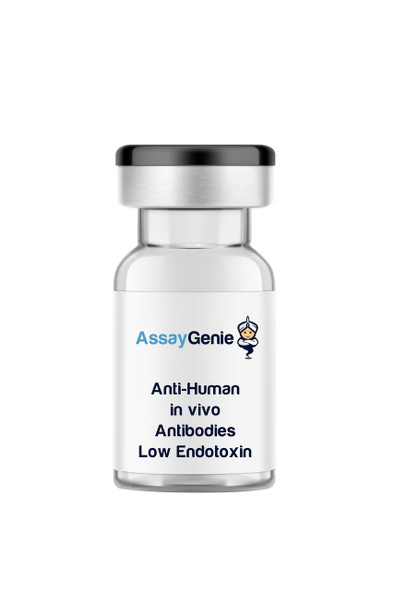Anti-CCR5 Antibody (CAB20261)
- SKU:
- CAB20261
- Product type:
- Antibody
- Antibody Type:
- Polyclonal Antibody
- Reactivity:
- Human
- Mouse
- Rat
- Host Species:
- Rabbit
- Isotype:
- IgG
- Synonyms:
- CKR5
- CCR-5
- CD195
- CKR-5
- CCCKR5
- CMKBR5
- IDDM22
- CC-CKR-5
Description
| Product Name: | CCR5 Rabbit pAb |
| Product Code: | CAB20261 |
| Size: | 50uL, 100uL |
| Synonyms: | CKR5, CCR-5, CD195, CKR-5, CCCKR5, CMKBR5, IDDM22, CC-CKR-5 |
| Applications: | WB, IF |
| Reactivity: | Human, Mouse, Rat |
| Host Species: | Rabbit |
| Immunogen: | A synthetic peptide corresponding to a sequence within amino acids 100-200 of human CCR5 (NP_000570.1). |
| Applications: | WB, IF |
| Recommended Dilutions: | WB 1:500 - 1:2000 IF 1:50 - 1:200 |
| Reactivity: | Human, Mouse, Rat |
| Positive Samples: | Rat liver |
| Immunogen: | A synthetic peptide corresponding to a sequence within amino acids 100-200 of human CCR5 (NP_000570.1). |
| Purification Method: | Affinity purification |
| Storage: | Store at -20°C. Avoid freeze / thaw cycles. Buffer: PBS with 0.02% sodium azide, 50% glycerol, pH7.3. |
| Isotype: | IgG |
| Sequence: | Email for sequence |
| Gene ID: | 1234 |
| Uniprot: | P51681 |
| Observed MW: | 41kDa |
| UniProt Protein Function: | CCR5: a 7-transmembrane G-linked receptor for a number of inflammatory C-C type chemokines including MIP-1-alpha, MIP-1-beta and RANTES. Transduces a signal by increasing the intracellular calcium ion level. May play a role in the control of granulocytic lineage proliferation or differentiation. Acts as a coreceptor (along with CD4) for HIV-1 R5 isolates. Interacts with PRAF2. Interacts with HIV-1 surface protein gp120. Efficient ligand binding to CCL3/MIP-1alpha and CCR4/MIP-1beta requires sulfation, O-glycosylation and sialic acid modifications. Glycosylation on S6 is required for efficient binding of CCL4. Interacts with ADRBK1. Interacts with ARRB1 and ARRB2. Variations in CCR5 are associated with resistance or susceptibility to immunodeficiency virus type 1 (resistance or susceptibility to HIV-1). Variations in CCR5 gene also influence the rate of progression to AIDS after infection. R60S variant, a naturally occurring mutation in a conserved residue in the first intracellular domain of CCR5, results in reduced amounts of the protein in the membrane and consequently may be associated with reduced susceptibility to infection by microbes that depend on these molecules as their receptors. Variations in CCR5 are associated with susceptibility to West Nile virus (WNV) infection |
| UniProt Protein Details: | Protein type:Receptor, GPCR; Motility/polarity/chemotaxis; Membrane protein, integral; Receptor, cytokine; Membrane protein, multi-pass; GPCR, family 1 Chromosomal Location of Human Ortholog: 3p21.31 Cellular Component: cell surface; integral to plasma membrane; cytoplasm; plasma membrane; endosome; external side of plasma membrane Molecular Function:protein binding; C-C chemokine receptor activity; chemokine receptor activity; coreceptor activity; C-C chemokine binding; actin binding; phosphoinositide phospholipase C activity Biological Process: viral reproduction; MAPKKK cascade; calcium-mediated signaling; release of sequestered calcium ion by sarcoplasmic reticulum into cytosol; chemotaxis; G-protein coupled receptor protein signaling pathway; elevation of cytosolic calcium ion concentration; cell surface receptor linked signal transduction; cell-cell signaling; calcium ion transport; dendritic cell chemotaxis; cellular defense response; immune response; entry into host cell; inflammatory response Disease: West Nile Virus, Susceptibility To; Diabetes Mellitus, Insulin-dependent, 22; Hepatitis C Virus, Susceptibility To |
| NCBI Summary: | This gene encodes a member of the beta chemokine receptor family, which is predicted to be a seven transmembrane protein similar to G protein-coupled receptors. This protein is expressed by T cells and macrophages, and is known to be an important co-receptor for macrophage-tropic virus, including HIV, to enter host cells. Defective alleles of this gene have been associated with the HIV infection resistance. The ligands of this receptor include monocyte chemoattractant protein 2 (MCP-2), macrophage inflammatory protein 1 alpha (MIP-1 alpha), macrophage inflammatory protein 1 beta (MIP-1 beta) and regulated on activation normal T expressed and secreted protein (RANTES). Expression of this gene was also detected in a promyeloblastic cell line, suggesting that this protein may play a role in granulocyte lineage proliferation and differentiation. This gene is located at the chemokine receptor gene cluster region. Two transcript variants encoding the same protein have been found for this gene. [provided by RefSeq, Jul 2008] |
| UniProt Code: | P51681 |
| NCBI GenInfo Identifier: | 1705896 |
| NCBI Gene ID: | 1234 |
| NCBI Accession: | P51681.1 |
| UniProt Secondary Accession: | P51681,O14692, O14693, O14695, O14696, O14697, O14698 O14699, O14700, O14701, O14702, O14703, |
| UniProt Related Accession: | P51681 |
| Molecular Weight: | 40,524 Da |
| NCBI Full Name: | C-C chemokine receptor type 5 |
| NCBI Synonym Full Names: | chemokine (C-C motif) receptor 5 (gene/pseudogene) |
| NCBI Official Symbol: | CCR5 |
| NCBI Official Synonym Symbols: | CKR5; CCR-5; CD195; CKR-5; CCCKR5; CMKBR5; IDDM22; CC-CKR-5 |
| NCBI Protein Information: | C-C chemokine receptor type 5; chemr13; HIV-1 fusion coreceptor; chemokine receptor CCR5; C-C motif chemokine receptor 5 A159A |
| UniProt Protein Name: | C-C chemokine receptor type 5 |
| UniProt Synonym Protein Names: | CHEMR13; HIV-1 fusion coreceptor; CD_antigen: CD195 |
| Protein Family: | C-C chemokine receptor |
| UniProt Gene Name: | CCR5 |
| UniProt Entry Name: | CCR5_HUMAN |




